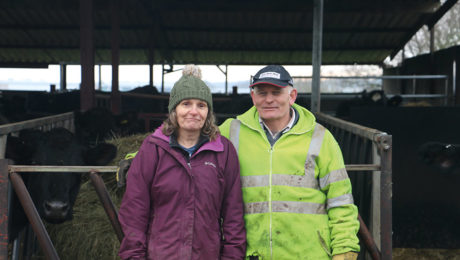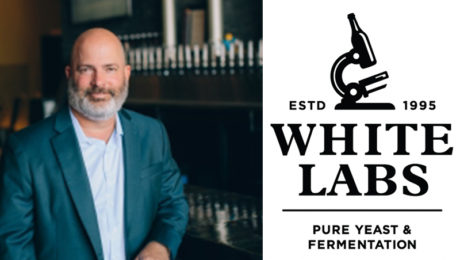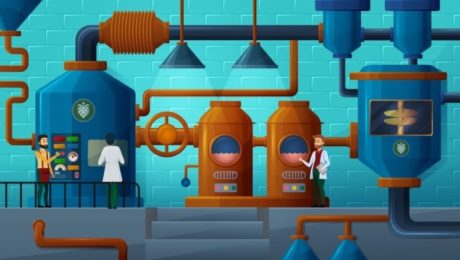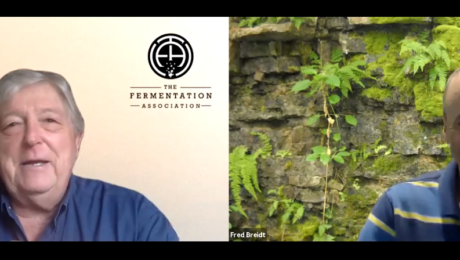New FDA Requirements for Fermented Food
By August, any manufacturer labeling their fermented or hydrolyzed foods or ingredients “gluten-free” must prove that they contain no gluten, have never been through a process to remove gluten, all gluten cross-contact has been eliminated and there are measures in place to prevent gluten contamination in production.
The FDA list includes these foods: cheese, yogurt, vinegar, sauerkraut, pickles, green olives, beers, wine and hydrolyzed plant proteins. This category would also include food derived from fermented or hydrolyzed ingredients, such as chocolate made from fermented cocoa beans or a snack using olives.
Read more (JD Supra Legal News)
Bokashi Farming
More farmers are using the Bokashi farming method, a Japanese technique that uses fermented organic matter to improve soil health.
Bokashi is an organic, anaerobic process that doesn’t use fertilizers, which are full of chemicals or plain manure that release carbon into the air. Instead, a mix of seashell, clay soil, muck and actiferm (which contains lactic acid bacteria, yeast and phototrophic bacteria) is layered in a pile, then sheeted for at least 6-8 weeks to keep oxygen out.
A UK couple, farmers, share their success story with Farmers Weekly. They heard about bokashi from the Pasture-Fed Livestock Association (PFLA) and were shocked to watch it absorb quickly into the soil when they applied it at their own cattle ranch. While fresh or composted organic matter must be broken down by soil microbes, bokashi has been predigested by those same microbes so that the nutrients are immediately available to the soil.
Read more (Farmers Weekly)
- Published in Science
Wildfires Cost California Wineries Billions
Devastating recent wildfires need to spur the California wine industry to invest in researching ways to mitigate the effects of fire and smoke damage. The California Wine Institute partnered with firm BW166 to calculate the cost of the 2020 wildfires to wineries; a $3.7 billion estimate includes loss of property, wine inventory, grapes and future sales.
“At a time of year when vintners would typically be throwing harvest parties and stomping grapes, they were instead faced with mounting uncertainty about the viability of their crop. Many of them decided not to make some or all of the wine that they’d planned to bottle because of the smoke damage. Months later, wineries are still deliberating over those decisions,” writes the San Francisco Chronicle.
Read more (San Francisco Chronicle)
- Published in Business
Global Fermentation: Today & Tomorrow
The health attributes and unique flavors of fermented food and drink are becoming increasingly more important to consumers. But, for fermentation brands to succeed in the food industry, they must prioritize their labeling and marketing, and focus on their environmental impact, says international food industry expert Lisa Moeller.
“Hopefully, it will be as advantageous to attach ‘Fermented’ as it is ‘Fresh Pack’ to shelf stable pickle products at some point in time,” says Moeller, speaking at a recent TFA webinar: Global Fermentation: Today & Tomorrow. “Never in our history has the power of positive change been more possible and necessary. I think there is an inherent history with fermented vegetables and a trajectory that can only take them higher going forward.”
After receiving her master’s degree in food science, Moeller spent 25 years working with Mount Olive Pickle Company in North Carolina. She later started her own company, Fashionably Pickled, where she consults to food brands on methods – such as assisting with traditional fermentation technology – for crafting better products.
Fred Breidt, microbiologist with USDA-ARS and a TFA advisory board member, called Moeller “one of the premiere pickle people in the United States,” and praised her for working around the world on a variety of fermentations.
Moeller shared three forecasts for fermented foods.
- Health Concerns Become More Important
Consumers are more concerned about their health during the COVID-19 pandemic. “Folks are looking to boost immunity, reduce their weight and they’re looking for nutritious options,” Moeller says.
People are also cooking more at home during the pandemic. Restaurant dining had continually increased over the previous two decades and, in recent years, only half the food eaten in the U.S. was purchased from a grocery store. But when COVID-19 hit, “this 23 year trend was blown out of the water,” says Moeller. By April 2020, 65% of the food consumed came from a grocery store, with less than 35% from restaurants.
“I think this trend gives the fermented vegetable arena great potential,” Moeller says. “Fermented vegetables can increase the shelf life of produce, they’re nutritious, and they can be turned into a wide variety of flavors. And I think for a time, people are going to be more interested in having a supply of things in their pantry when they don’t feel comfortable going to a grocery store.”
Increased research will help promote fermentation as a viable health food. There are still consumers who are off-put by fermentation, leaving room for brands to educate.
“Though a large part of the pickle industry is still involved with fermented cucumbers, it is not the leader in the retail category at this time,” Moeller says. “We don’t label ‘fermented’ in America. Lots of times with the cucumber industry, the fermented kind of becomes the offshoot. It’s kind of the have-to-do so you can produce all the fresh pack that you want and still have a home for others.”
- Labelling and Marketing Are Crucial
Food product labels and marketing must adapt to their local markets. Brands must create different labelling, packaging and marketing plans, depending on the country.
“There truly is no such thing as global tastebuds. But there are successful product adaptations,” Moeller says.
Consider Kentucky Fried Chicken (KFC) as an example. There are over 23,000 KFC locations in 140 countries, and the restaurants adapt to regional flavor preferences, selling different styles of food depending on the location. Coca-Cola is another example. With 500 brands in 200 countries, a can of Coke will taste different depending on the country where it was sold.
“Labelling is even more important when selling your brand. Know what is important to the folks that are going to make the decision to add you products to their store shelves. Whole Foods is different than Walmart,” Moeller adds.
She advises to never make a label too complicated. Yogurt sales are projected to drop by 10% by 2024 “and this is partially because there are too many choices and the category has gotten too complicated.”
- Environmental Concerns Lead to Upcycllng
The environment is a big topic of concern worldwide, Moeller says.The global food system accounts for 26% of greenhouse gas emissions, 40% of the food produced is never consumed and 78% of global consumers are concerned about the environment.
Upcycling will be the new food trend. Brands like Toast Ale (beer made from old bread) and RISE + WIN Brewing Co. (who recycle grain scraps to make granola and sweets) are already making waves in the industry. During the pandemic, chefs reported using fermentation more than ever before to make use of uneaten produce.
“There’s not a vegetable out there that could be turned into something else,” Moeller says. “Turning food waste into alternative products…I think it’s one of the most wonderful ideas, (brands) need to partner with the folks that they want to get these byproducts from.”
- Published in Business, Food & Flavor
Food and Beverage Laws Passed in 2020
Every year, the nation’s 50 state legislatures pass dozens of new laws that have an impact on fermenters. For example, some states amended alcohol laws to allow drink sampling for craft wineries, while others repealed outdated cottage food laws to help small producers operate and more loosened take-out restrictions to help small restaurants survive the pandemic.
Indicative of this year’s focus on the pandemic, laws were introduced but never debated as lawmakers focused on more pressing issues surrounding the coronavirus. The most common new laws passed in 2020 revolved around helping businesses survive — states called special sessions to aid restaurants, stop price gouging of high-demand products and provide emergency grants to small businesses.
Read on for key food, beverage and food service laws passed this year, most taking effect in 2021.
California
AB82 — Prohibits an establishment with an alcohol license from employing an alcohol server without a valid alcohol server certification.
AB3139 — Establishments with alcoholic beverages licenses who had premises destroyed by fire or “any act of God or other force beyond the control of the licensee” can still carry on business at a location within 1,000 feet of the destroyed premise for up to 180 days.
Delaware
HB 237 — Eliminates old requirements that movie theaters selling alcohol must have video cameras in each theater, and that an employee must pass through each theater during a movie showing.
HB275 — Permits beer gardens to allow leashed dogs on licensed outdoor patios.
HB349 — Permits any restaurant, brewpub, tavern or taproom with a valid on-premise license to sell alcoholic beverages for take-out or drive through food service, so long as the cost for the alcohol did not exceed 40% of the establishment’s total sales transactions.
Hawaii
SR84 — Creates a Restaurant Reopening Task Force to help restaurants in Hawaii safely reopen that were closed during the COVID-19 pandemic.
SR94 — Urges restaurants to adopt recommended best practices and safety guidelines developed by the United States Food and Drug Administration and National Restaurant Association in response to the COVID-19 pandemic.
Idaho
HB343 — Amends existing law to require licensing to store and handle wine as a wine warehouse.
HB575 — Allows sampling of alcohol products at liquor stores, which was formerly forbidden under law.
SB1223 — Eliminates obsolete restrictions on food products, to match federal standards. It repeals requiring extra labels on some imported food products, and repeals using enriched flour in bread baking.
Illinois
HB2682 — Amends Liquor Control Act of 1934. Allows a cocktail or mixed drink placed in a sealed container at the retail location to be sold for off-premises consumption if specified requirements are met. Prohibits third-party delivery services from delivering cocktails or mixed drinks.
HB4623 — Amends Food Handling Regulation Enforcement Act, regulating that public health departments provide a certificate for cottage food operations, which must be displayed at all events where the licensee’s food is being sold.
Iowa
HB2238 — Amends code regarding food stands operated by a minor. Bans a municipality from enforcing a license permit or fee for a minor under the age of 18 to sell or distribute food at a food stand.
Kentucky
HB420 — Implements Food Safety Modernization Act, authorizing a department representative to enter a covered farm or farm eligible for inspection.
SB99 — Amends alcohol laws for state’s distillers, brewers and small wineries. Eliminates the sunset on local precinct elections to grant distilleries, and allows distillers to sell other distiller’s products.
Louisiana
HR17 — Allows third-party delivery services to deliver alcohol.
HB136 — Makes adulterating a food product by intentional contamination a crime.
SB455 — Increases the size of containers of high-alcoholic beverages.
SB508 — Gives restaurants protection from lawsuits involving COVID-19. The public will be unable to sue restaurants for COVID-19-related deaths or injuries, as long as the restaurant complies with state, federal and local regulations about the virus.
Maine
LD1167 — Encourages state institutions to serve Maine food and Maine food products, increasing the visibility of the state’s local food producers.
LD1884 — Amends current laws regarding businesses that hold dual liquor licenses, which authorized retailers to sell wine for consumption both on- and off-premise. Retailers with the dual license can now sell with just one employee at least 21 years of age present, and adds that wine can be sold for take-out if food is part of the transaction.
Maryland
HB1017 — Allows cottage food businesses to put their phone number and business ID on their food label, rather than their address as currently required by the Maryland Department of Health.
SB118 — Expands definition of “alcohol production” and “agricultural alcohol production.” The new definitions aim to give Maryland farmers and producers the ability to sell beer, wine and spirits to increase agritourism.
Massachusetts
SB2812 — Expands alcohol take-out and delivery options during COVID-19 pandemic. Allows restaurants to sell mixed drinks in sealed containers alongside other take-out and delivery food orders.
Michigan
HB5343 — Revises regulations on brewpubs and microbreweries, increasing the quantity of beer a microbrewer is permitted to deliver to a retailer during a year from 1,000 barrels to 2,000 barrels.
HB5345 — Amends the Michigan Liquor Control Code to delete the Michigan Liquor Control Commission (MLCC) $6.30 tax levied on each barrel of beer manufactured and sold in Michigan.
HB5354 — Amends the Michigan Liquor Control Code to delete the requirement that a brewpub cannot sell beer in Michigan unless it provides for each brand or type of beer sold a label that truthfully describes the content of each container.
SB711 — Establishes new limited production brewer license for microbreweries at cost of $1,000 for license.
HB5356 — Amends the Michigan Liquor Control Code to ban the required $13.50 cent-per-liter tax on all wine containing 16% or less of alcohol by volume sold in Michigan.
Minnesota
HB5 — Authorizes emergency, small-business grants and loan funding for businesses affected by COVID-19.
HB4599 — Extends period of mediation for Minnesota farmers suffering economic difficulties to keep their farm.
Mississippi
HB326 — Amends outdated code to increase the maximum annual gross sales for a cottage food operation (from $20,000 to $35,000) before the producer would need to pay food establishment permit fees. Authorizes a cottage food operation to advertise products over the internet.
New Jersey
AB2371 — Requires large generators of food waste (like restaurants and supermarkets) to recycle food garbage rather than send it to incinerators or landfills.
AB3865 — Limits return of food from retail food stores during a public emergency.
SB864 — Prohibits sale of single-use plastic carryout bags, single-use paper carryout bags and polystyrene foam food service products, and limits single-use plastic straws.
SB1591 — Allows alcoholic beverages to be consumed from open containers in the Atlantic City Tourism District.
SB2437 — Limits service fees charged to restaurants by third-party food takeout and delivery applications during COVID-19 pandemic.
New Mexico
SB3 — Enacts the Small Business Recovery Act of 2020, which provides loans for small businesses suffering during the coronavirus pandemic.
New York
SB8225 — Authorizes issuing a retail license for on-premise consumption of food and beverage within 200 feet of a church, synagogue or other place of worship.
AB8956 — Allows a licensed brewery or farm brewery to provide no more than four beer samples not exceeding four fluid ounces each.
SB1472 — Requires hospitals to offer plant-based food options to patients upon request.
SB7013 — Authorizes the manufacture and sale of ice cream or other frozen desserts made with liquor.
North Carolina
SB290 — The Alcoholic Beverage Control Regulatory Reform Bills, it allows distilleries the same serving privileges as wineries and craft breweries and reduces regulation on out-of-state sales.
Ohio
HB160 — Aid for the restaurant industry to recover from COVID-19 pandemic, the bill doubles the maximum number of Designated Outdoor Refreshment Areas (DORAs) that can be created in a municipality or township. Also allows Ohio’s small wineries to sell prepackaged food without regulation from the Ohio Department of Agriculture, creates bottle limits for micro-distilleries and permits license holders to sell alcoholic ice cream.
South Carolina
HB4963 — Amends state alcohol code, allows licensed retailers to give wine samples in excess of 16% alcohol, cordials or distilled spirits, as long as they don’t exceed a total of three liters a year.
SB993 — Amends state alcohol code to allow a permitted winery to be eligible for a special permit to sell wine at off-premise events. Also increases the amount of beer a brewery can sell to an individual per day for off-premise consumption.
South Dakota
HB1073 — Authorize special event alcohol licenses for full-service restaurant licensees.
HB1081 — Allows colleges to teach brewing beer and wine classes on South Dakota campuses to students age 21 or older. Brewing must be held off campus as the education institution is not deemed a licensed manufacturer. Any distilled spirits, malt beverage, or wine produced under this section may only be consumed for classroom instruction or research and may not be donated or sold.
Tennessee
SB2423 — Allows alcohol sales at the Memphis Zoo.
SB1123 — Encourages farmers who produce raw milk to complete a safe milk-handling course.
Utah
HB134 — Legalizes the sale of raw butter and raw cream in Utah;
HB232 — An agri-tourism bill that allows farms and ranches to host events that include food that would not need to be prepared in a commercial kitchen. Farmers must apply for a food establishment permit to use their private home kitchen.
HB399 — Changes to the Alcohol Beverage Control Act, prohibits advertising that promotes the intoxicating effects of alcohol or emphasizes the high alcohol content of an alcoholic product.
HB5010 — The COVID-19 Cultural Assistance Grant Program, which appropriates $62 million for struggling arts, cultural and recreational organizations and businesses across the state.
HB6006 — In response to the coronavirus pandemic, the bill amends the Alcohol Beverage Control Act, delaying the expiration date of the retail licenses set to expire in 2020 for places selling alcohol. Also permits alcoholic beverage licensees at international airports to change locations if needed.
Vermont
SB351 — A coronavirus relief bill which authorizes $36 million for agriculture and forestry sectors.
Washington
HB2217 — An update to Cottage Food Law eliminates the requirement that a home address must be put on a food label.
HB2412 — Increases amount of additional retail licenses for a domestic brewery or microbrewery from two to four, and directs health department to adopt rules allowing brewery owners to allow dogs on brewery premise
SB5006 — Allows sale of wine by microbrewery license holders.
SB5323 — A bill eliminating single-use, plastic carry-out bags
SB5549 — Modernizing resident distillery marketing and sales restrictions. Allows distilleries to sell products off-premise, similar to breweries and wineries.
SB6091 — Continues work on the Washington Food Policy Forum, including support for small farms and increasing the availability of food grown in the state.
West Virginia
HB4388 — Removes outdated restrictions on alcohol advertising, limiting the Alcohol Beverage Control Commissioner’s authority to restrict advertising in certain advertising mediums, such as at sporting events and highway billboards.
HB4524 — Making the entire state “wet,” permitting the off-premises sale of alcoholic liquors in every county and municipality in the state.
HB4560 — Permits licensed wine specialty shops to sell wine with a gift basket by telephonic, electronic, mobile or web-based wine ordering. Establishes requirements for lawful delivery.
HB 4697 — Removes restriction that a mini-distillery use raw agricultural products originating on the same premises
HB4882 — Allows unlicensed wineries not currently licensed or located in West Virginia to provide limited sampling and temporary, limited sales for off-premise consumption at fairs, festivals and one-day nonprofit events “in hopes that such wineries would eventually obtain a permanent winery or farm winery license in West Virginia.”
Wisconsin
HB1038 — Bans customers from returning food items during a health pandemic or emergency, dissuading people from stocking up on too many supplies.
SB83 — Increases sales volume of alcohol by retail stores from four liters per transaction to any quantity.
SB170 — Allows minors to operate temporary food stands without a permit or license.
Wyoming
HB82 — Authorizes a microbrewery to operate at more than one location. The local licensing authority may require the payment of an additional permit fee not to exceed $100.00.
HB84 — Authorizes the sale of certain homemade food items that do not require time or temperature control. These include but are not limited to:
but is not limited to, jams, uncut fruits and vegetables, pickled vegetables, hard candies, fudge, nut mixes, granola, dry soup mixes excluding meat based soup mixes, coffee beans, popcorn and baked goods that do not include dairy or meat frosting or filling or other potentially hazardous frosting or filling;
“non-potentially hazardous” (no dairy, quiches, pizzas, frozen doughs, foods that require refrigeration and cooked meat, cooked vegetables and cooked beans). Allows someone other than the producer to sell the food, as long as food is not sold in a retail location or grocery store where similar food items are displayed or sold. Food must be labeled with “food was made in a home kitchen, is not regulated or inspected and may contain allergens.”
HB158 — Allows microbreweries to make malt beverages at multiple locations rather than one as deemed in current law.
Q&A with Chris White, White Labs
As a biochemistry grad student with a penchant for homebrewing, Chris White never thought his growing collection of yeast strains would amount to anything outside a hobby. But when White graduated with his PhD and was offered a lucrative job in the biotech field, one caveat kept him from accepting the offer — there were no side jobs allowed.
“I never had some big plan to start a company. But I liked all the fermentation stuff I was doing and didn’t want to let go of my yeasts,” says White, CEO and founder of White Labs. “I said no to the job, and from there White Labs kept going and going and getting bigger and bigger.”
Today, White Labs is a powerhouse in the fermentation industry. They provide professional breweries with liquid yeast, nutrient blends, educational classes, analytic testing and private consulting.
White Labs is celebrating a landmark 25th anniversary this year, despite a global pandemic that has shuttered breweries. They have released their own line of beer, created a new nutrient blend for hard seltzer brands, began a YouTube series and launched free how-to education classes for homebrewers. White Labs will host a year in review webcast on Dec. 9.
“We’ve had a lot of success and we’ve made a lot of mistakes, and we’ve tried to learn from those mistakes. But we’re a team. And we really got lucky that we hired people interested in fermentation that helped build this company,” White says. “Everyone really pulled together during COVID and did whatever was needed. It’s been a great experience because we had solutions and we had teamwork. And I think it’s taken 25 years to get to that team, that tribe.”
A yeast guru, White is a co-author of the book “Yeast: The Practical Guide to Beer Fermentation.” Below, check out our Q&A with White.
The Fermentation Association: You studied biochemistry at University of California, Davis, then got your PhD in biochemistry at University of California, San Diego. What made you decide to dive into yeasts?
CW: I was always interested in science since high school chemistry, and then in college was interested in how cells work, how DNA worked. It drove me to where I am today, really. Most people I went to school with at UC Davis, they were studying biochemistry to be a physician. But that’s not what I wanted to do, I was more interested in biotech and grad school.
Meanwhile, I was homebrewing. It was a great combination of things that happened. The science and homebrewing is what led me to put that together and make yeast for homebrewing, then yeast for craft brewing.
TFA: Is that what led you to start White Labs?
CW: It really was. I like beer. I was fascinated with how it could be made. It’s pretty simple to make beer — simple, but not easy. It’s difficult to make a great beer. But it’s fairly simple since it’s only four ingredients if you include the water. That’s what’s great about a lot of fermentation, the raw materials are all around you. They’re simple. Making it taste good is the hard part, that’s the art of it. I liked beer, I really got into homebrewing, then the people I was making homebrewed beer with started a store in San Diego, Home Brew Mart, in 1992. We became friends and that’s who I was homebrewing with every weekend. Then my friend from the store said “Hey, we need yeast,” and I started a little company on the side to make yeast. It wasn’t like I had some big plan to start a company, I thought I’d just make a little each week. And then other people asked and other people asked. By the time I got closer to finishing grade school, I just didn’t want to stop doing the yeast for brewing.
TFA: Now there are over 1,000 strains of yeast in the White Labs yeast bank. Tell me about it.
CW: We have a yeast bank that I spent a lot of time building in the beginning, more for my own brews, but obviously later on, it became more and more. The foundation of our company is our yeast strains and the way we store them. We’re collecting strains all the time. But what I did in the beginning was collect different strains from travel, from different yeast banks. We created our own private yeast bank at White Labs, but there are yeast banks around the world. Especially in Europe where brewing really began in an industrial way and where yeast was discovered and started to get collected. There’s a great yeast bank in Denmark, Germany, the UK. I spent a lot of time acquiring strains from those.
You get to know the yeast in a different way, the strains, what they do. Performance, conditions. But for beer especially, it’s really how they taste, which is so important. We only make those flavors through fermentation. We still continue to acquire strains. People send them to us, we bank private strains for companies, sometimes they buy them in a liquid form we make for them, sometimes we just store it for them. But usually, they’re banking it for us to make something with it.
TFA: Besides yeast, White Labs offer testing services as well.
CW: White Labs Analytical Lab is really separate in the fact that a lot of people that work in that lab don’t really have anything to do with the yeast. It’s just testing samples. They’re usually fermented beverages. Yes, there’s beer there, but that’s just a part of White Labs Analytical Lab. There’s the spirits that come for testing, kombucha, cider, mead, any kind of commercial business making a fermented beverage that needs some kind of testing. Sometimes it’s regulatory for export. Sometimes it’s just for their own data, like actual alcohol by volume instead of calculated, sometimes it’s microbiology or tracking down a problem or contamination. It’s all confidential, like everything at White Labs. But we get to work with a lot of cool companies, a lot of them may not get yeast from us, that’s really not a requirement. The yeast and testing run separate.
TFA: Have you seen kombucha brewing grow?
CW: Oh yeah. Originally, that’s how we got into analytical testing because people were asking for alcohol lab evaluations, which is so important in kombucha. We all know what happened there (Whole Foods pulled all kombucha bottles off shelves in 2010 after several brands tested at higher alcohol beverage levels then what was printed on the bottles). And it happened because it’s a biological process. You put that thing in a bottle and it’s going to keep fermenting. People had to really try to figure out what to do with that. So a lot of alcohol testing, and a lot of that is regulatory in kombucha.
But then we started making SCOBYs because a couple of our staff got really into it. Just like I started making yeast in my own home brewing, they started making SCOBY in White Labs for their own kombucha making. So we said “Let’s sell it.” And now we make a bunch of it.
TFA: That’s forward-thinking, expanding your offerings to all fermented drink products.
CW: Yeah and the different facilities allow us to do different things. We grow all the SCOBYs in North Carolina because it was a new facility at the time and had the space, San Diego is full.
TFA: White Labs released their own canned beer in July. Tell me about it.
CW: A lot of the things that came out of this year really were not new ideas, like canning. Someone gave a presentation at White Labs during one of our internal innovation summits that’s open to anyone in the staff about canning beer. But during this time of COVID, when we’re not focusing on growth, we were able to work on a lot of those projects and really build a better company. Once we gave up the idea that revenue is not going to go up right now, we worked on other things. And it’s been great. A lot of cool things have been coming out of our teamwork this year, and one of those was canning.
So we said let’s do that because we’re not selling beer in our tap room — we’ve got a tap room in San Diego for White Labs Brewing Company and a kitchen and tap in Asheville, it’s more of a full restaurant. We weren’t selling a lot of beer and we have a lot of beer, so why not can it? We have done three different beers now in cans. The IPA, a hazy IPA and the pilsner. And we’re going to do another lager and IPA next month. It’s been fun for the brewers to be able to brew it. I think it’s been a nice boost for everyone in the company, not even money wise, just to have another milestone: we put our beers in cans. It’s a nice billboard for the brewery. And they get to have fun with graphics, and how to tell our story, and really share what we’re doing in the tap rooms.
People are amazed that it’s the same beer, same exact batch but put into smaller fermenters and pitched with two different yeast strains. They say “Wow, you created different flavor beers? They taste different?” Yeah, because that’s fermentation. Fermentation makes these flavors and when people taste that it’s the same exact beer made with two different yeast strains, they get it in 30 seconds. “Oh that’s what a yeast does?” But you have to come to our tap room to experience that. And obviously during these times, you can’t come to the tap room. But canning is a way to share that with people outside the tap rooms.
TFA: Who buys more yeast from White Labs — commercial producers or homebrewers?
CW: Commercial because of volume. But we’re available for everything in homebrew. We try to mirror every test, every yeast strain, and make those available for home brewing because that’s our roots and I think it’s important. There’s been growth in home brewing during COVID. People at home with a hobby are buying yeast. That’s kind of nice, I like to see that.
TFA: Craft brewing has been hit so hard by pandemic. What have you seen your clients doing to survive?
CW: They’re getting creative. People had to figure out the to-go thing, first of all. That maybe involved buying software or creating a new website. Each company I talk to, regardless of what industry, they had to do something technology wise. Very few could close the bar door and were all set up to sell everything through the warehouse.
I think customers were also really good about supporting local businesses, wanting to help them. There’s been a lot of to-go. But it still doesn’t compare to all the beer they could sell, all the stuff that gets sold through bars. Even if one little meadery sells more to go, it doesn’t replicate all the tap room business that just disappears.
TFA: What do you think is the future of the fermented drink industry?
CW: It’s up to them. We pay attention so we can be there to help. But really these things come from creative people. New things have to come out. That keeps the industry growing. And I don’t know what those new things are, but we try and pay attention.
I think transparency and honesty is a hallmark of fermentation industries — whether craft breweries or wineries — and I hope that stays. That’s been a big part of the trust with consumers, and the fact that you can do these things at home too, so you know how it’s done. And with new techniques or things that get introduced, I think the industry needs to keep the transparency part of the business. Because fermentation being such an old, old method — a lot of people would like to replace fermentation with something else. They say “Let’s just mix these things together rather than do that weird fermentation.” But weird fermentation is what makes it so special.
- Published in Business, Food & Flavor
Alternative Protein Grows with Microbial Fermentation Technologies
Microbial fermentation is emerging as the “third pillar in the alternative protein industry,” alongside cell-culture and plant-based, according to the Good Food Institute. In 2020, protein alternatives made using microbial fermentation have attracted $435 million in investment capital. The institute released a 72-page report on fermentation in the alt protein industry and noted that its “potential is still largely untapped.” Nature Fynd CEO Thomas Jonas points out it takes years to grow animals, and months or years to grow plants, but microbes can double their biomass in a few hours. Are these novel fermentation techniques to produce animal-free meat and dairy improving our food system or too big of a departure from traditional fermentation?
Read more (Food Navigator)
- Published in Science
Introduction to HACCP
Creating a HACCP plan — a management system to control food preparation risk — can overwhelm food producers. But Charlie Kalish, food safety consultant and trainer, emphasizes HACCP (Hazard Analysis Critical Control Points) is vital to food safety.
“This is just as important as trying to understand, when I ferment things, why do I ferment? What are the things that get you excited about why you get the flavors that you get or the textures that you get (when you ferment)? The food safety thing, it’s really going to help you in the long run if you approach it with the same excitement because, if you don’t, it’s going to be a lot of work and it will drag you down,” Kalish says during the recent TFA webinar Introduction to HACCP. “I see a lot of people get bitter about (HACCP). ‘It’s such a drain on my resources and what I do!’ But it can help your product get better, it can help you get into new markets. And it is a different language, a different world. Even if you’re not going to get a PhD to understand the basic science underlying the mechanisms, having a strong control of HACCP, food safety, what the expectations are, it’s really going to help you.”
HACCP was originally created for the space program in the ‘60s. NASA needed a high level of assurance that food was going to be safe during missions in space, but traditional food models did not have enough preventive food safety controls. That plan was later adopted by the USDA and FDA to regulate food products.
“HACCP shifted the focus away from recalling food and trying to do damage control with outbreaks to preventing those things from happening in the first place,” Kalish says. “HACCP, in summary, is a systematic approach where we consider all of our ingredients, we consider every process step from when we receive our raw materials or ingredients all the way to the shipping out of our final product, it considers all reasonable and foreseeable hazards.”
Kalish points out HACCP controls for things with a high probability of occuring, like an E. Coli outbreak in lightly fermented food. And a good HACCP plan begins with a solid foundation, basic practices like regular hand washing, sanitizing surfaces and maintaining a comprehensive food safety employee training program.
“Common sense is an excellent guide to get you started for food safety, but I would further suggest to learn as much as you can: the science of the system you’re working with, the microbiology, pH, what it is, how you measure it,” says Fred Breidt, PhD, a microbiologist with the Agriculture Research Division of the USDA. Breidt joined Kalish during the webinar along with moderator Dave Ehreth, president of Sonoma Brinery; both are TFA advisory board members.
Luckily for fermenters, fermentation is a critical control point. In one study on kimchi by Breidt and his USDA colleagues, they found pH level is critical for food safety, a factor controlled by fermentation.
Though the internet can be a wonderful resource to find information on food safety, “you have to be judicious about your sources,” Breidt says. Kalish says to look for guidance from government sources, scientific literature, process authorities, university extension specialists, industry groups and publications or consultants.
Food producers need to budget for HACCP in their financial plan, Kalish advises. Ehreth agrees, and encourages producers still unsure of the process to pay a professional for help “to understand what potential biological hazards could be in that jar of food.”
“The modern food manufacturer is not only a food manufacturer, he is a protector and is entering into a bond of trust with his customers. And that bond of trust says ‘If you buy what I make, you’re not going to die as a result,” Ehreth adds. Though he notes it sounds like extreme advice, it’s a necessity for food producers to keep that creed at the forefront of their production.
- Published in Science
Development of Pickling Technologies & Products
There’s a void in scientific knowledge of fermented and pickled vegetables, and scientists are just starting to scratch the surface.
“We have a wealth of chemical compositions that we still don’t fully understand,” says Dr. Ilenyz Pérez-Díaz, PhD, a microbiologist with the USDA-ARS. Perez-Diaz presented on “Development of Pickling Technologies & Products” during a webinar hosted by TFA. “I honestly think there is still a lot to do in regards to the richness of the biological functions that are present in these systems. Every vegetable is different. … It will be fantastic to be able to comprehensively understand what’s really there and how we can use it for the benefit of not only processing but also for the benefit of human health.”
The purpose of the USDA-ARS is to find solutions for agricultural challenges, domestically and globally. In 2019, the 8,000 employees of the USDA-ARS researched 660 agricultural projects, filed 85 new patents, issued 65 new patents, received 51 new licenses and wrote 3,816 peer-reviewed journal articles.
Pérez-Díaz is assigned to the food science and market quality and handling research unit. There the team develops state-of-the-art, science-backed methods that improve the post-harvest processes, food preservation, food quality and safety and, ultimately, introducing nutritious products into the food system.
“What I love about the research that she’s doing is that pickling and fermentation are these ancient, traditional technologies that people have been using for hundreds and hundreds of years, and she’s really thinking about ways that we can advance those technologies using all the amazing sequencing and all the microbiology we have today,” says Ben Wolfe, PhD, associate professor of biology at Tufts University, and the TFA Advisory Board member who moderated the webinar.
Pérez-Díaz shared the USDA’s latest technologies to reduce food waste, lessen environmental impacts, improve water/energy demand and add more health value to preserved vegetables. Here are highlights from the research presented, focused on addressing two key problems:
Eliminate Salt in Cucumber Fermentation
PROBLEM: Sodium chloride is essential to fermentation, but the salt-rich (and sometimes preservative-filled) brine shipped from overseas producers can get into local freshwater supplies. There are no growers of small cucumbers (gherkins) in the U.S., so food projects that require small cucumbers must use overseas produce. But, in order for the cucumbers to be transported, they must be fermented or pickled. High amounts of salt, acid and sometimes preservatives are added, and these potentially can damage the water supply.
SOLUTION: USDA-ARS tested fermenting pickles using three popular spices: dill, cinnamon and mustard seed. But, though salt was reduced or eliminated, “the indigenious microbiota is always there,” Pérez-Díaz explains. “The salt is modulating the activity within this population. It tends to favor the lactic acid bacteria. But what I’ve learned is it is not the main factor modulating that microbiota. The ph and the production of that lactic acid and or acetic acid is really the factor in excluding the non desirable microorganisms and favoring the fermentative microbiota.”
Reduce Food Waste by Creating Foods
PROBLEM: In the U.S., between 30-70% of fresh vegetable produce is wasted. “Those are alarming numbers,” says Pérez-Díaz. “Even though they are estimates, it is necessary to look at ways to resolve the impact of such waste.”
SOLUTION: The USDA developed small-scale fermentation systems for use in restaurants, farmer’s markets and grocery stores. These vessels make fermenting excess food more manageable by allowing easy fermentation of smaller batches.
“We can convert what was waste or surplus or defective vegetables into a value-added product,” Pérez-Díaz says. “It will be a probiotic product, it will be fermented vegetables auxiliaries that can be used as sources of flavor, colors, ingredients in a number of recipes or even dehydrated for different applications.” [This project was near completion before the pandemic and is expected to pick-up soon.]
Fermentation, she emphasized, is needed to sustain a modern food system.
“These fermentations, if applied properly, they are very powerful eliminating the organisms that are not desirable or the organisms that are not of health significance,” Pérez-Díaz says. “I think fermentation will truly be an important component as we move forward to that new era.”
- Published in Science
Science Behind Fermented Vegetable Safety
Just because vegetables were fermented does not make them immune to harmful bacteria like E. coli. Though fermentation improves food safety, the quality of the raw vegetable before it’s fermented is extremely important.
“The issue of fermentation safety is one that comes up a lot. People are getting excited about the fermentation world these days, fermentation is increasing in popularity…(but) the wheels can fall off if you’re not careful,” says Fred Breidt, PhD, a USDA microbiologist. Breidt spoke during a recent webinar hosted by The Fermentation Association, “The Science Behind the Safety of Fermented Vegetables.” “The moral of the story: if the vegetables were safe to eat before you ferment them, they’re going to be safe to eat after you ferment them. If they’re not, you’ve got to ferment them for a long time to make sure they’re safe.”
An outbreak of dangerous bacteria in fermented vegetables, “it’s going to be pretty rare that that happens,” Breidt stresses. But, without proper sanitation protocol and vegetable quality control, pathogenic “bad guys” can flourish, like E. coli, salmonella and listeria. E. coli is more common in vegetables because it’s extremely acid resistant, and can survive for long periods of time at low pH levels and cold temperatures.
“Just washing the surface (of the vegetable) isn’t always going to do the trick,” Breidt says. “You don’t have to eat very much to get sick.”
An E. coli outbreak in kimchi made 230 Korean school children sick in 2013. The children, from seven different schools, all ate fermented kimchi made by the same manufacturer.
“If the folks had eaten the cabbage that this kimchi was made out of, they would have gotten sick as well,” Breidt says. “Was the cabbage improved in the sense of maybe it had fewer E. coli on it because of fermentation? Yes. But there was still enough when this was eaten to make a lot of people sick.”
“You can’t rely on salt for safety is the point,” he adds. “It does encourage the lactic acid bacteria and it helps them grow and it will increase overall the safety of your fermentation.”
David Ehreth, president and founder of Alexander Valley Gourmet, parent company of Sonoma Brinery, moderated the webinar. Ehreth first met Breidt when Sonoma Brinery made a few tons of sauerkraut that became infected with yeast. Ehreth says “I called Ghostbusters, and that’s Fred Breidt.” Though yeast is different from a pathogen like E. coli, Ehreth said Sonoma Brinery has managed to control yeast over the years by careful management of production techniques and improved sanitation methods.
- Published in Science










